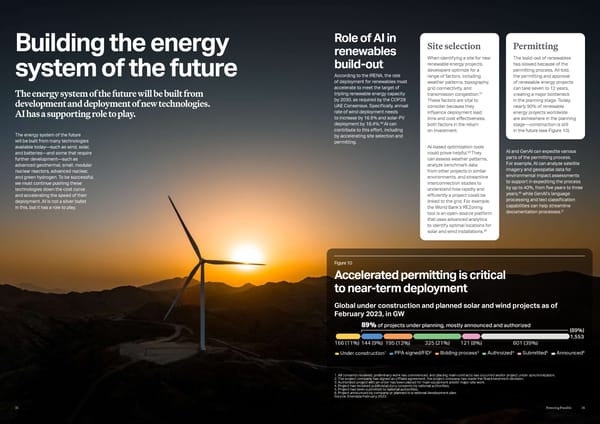Global under construction and planned solar and wind projects as of February 2023, in GW Under construction1 PPA signed/FID2 Bidding process3 Authroized4 Submitted5 Announced6 89% of projects under planning, mostly announced and authorized (89%) 1,553 166 (11%) 144 (9%) 195 (13%) 325 (21%) 121 (8%) 601 (39%) 1. All consents received, preliminary work has commenced, and placing main contracts has occurred and/or project under synchronization. 2. The project company has signed an offtake agreement, the project company has made the final investment decision. 3. Authorized project with an order has been placed for main equipment and/or major site work. 4. Project has received public/statutory consents by national authorities. 5. Project has been submitted to national authorities. 6. Project announced by company or planned in a national development plan. Source: Enerdata February 2023. Building the energy system of the future The energy system of the future will be built from many technologies available today—such as wind, solar, and batteries—and some that require further development—such as advanced geothermal, small, modular nuclear reactors, advanced nuclear, and green hydrogen. To be successful, we must continue pushing these technologies down the cost curve and accelerating the speed of their deployment. AI is not a silver bullet in this, but it has a role to play. The energy system of the future will be built from development and deployment of new technologies. AI has a supporting role to play. Site selection When identifying a site for new renewable energy projects, developers optimize for a range of factors, including weather patterns, topography, grid connectivity, and transmission congestion.57 These factors are vital to consider because they influence deployment lead time and cost effectiveness, both factors in the return on investment. AI-based optimization tools could prove helpful.58 They can assess weather patterns, analyze benchmark data from other projects in similar environments, and streamline interconnection studies to understand how rapidly and efficiently a project could be linked to the grid. For example, the World Bank’s REZoning tool is an open-source platform that uses advanced analytics to identify optimal locations for solar and wind installations.59 Permitting The build-out of renewables has slowed because of the permitting process. All told, the permitting and approval of renewable energy projects can take seven to 12 years, creating a major bottleneck in the planning stage. Today, nearly 90% of renewable energy projects worldwide are somewhere in the planning stage—construction is still in the future (see Figure 10). Figure 10 Accelerated permitting is critical to near-term deployment According to the IRENA, the rate of deployment for renewables must accelerate to meet the target of tripling renewable energy capacity by 2030, as required by the COP28 UAE Consensus. Specifically, annual rate of wind deployment needs to increase by 16.9% and solar-PV deployment by 18.4%.56 AI can contribute to this effort, including by accelerating site selection and permitting. Role of AI in renewables build-out AI and GenAI can expedite various parts of the permitting process. For example, AI can analyze satellite imagery and geospatial data for environmental impact assessments to support in expediting the process by up to 40%, from five years to three years,60 while GenAI’s language processing and text classification capabilities can help streamline documentation processes.61 36 Powering Possible 35
 Powering Possible 2024: AI and Energy for a Sustainable Future Page 18 Page 20
Powering Possible 2024: AI and Energy for a Sustainable Future Page 18 Page 20